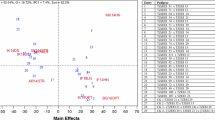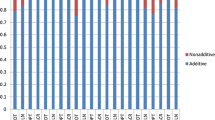Abstract
CIMMYT (International Maize and Wheat Research Institute) Zimbabwe’s early maturing maize program, which aims to supply seed to approximately 4 million hectares of maize area in eastern and southern Africa, lacks adequate information on heterotic relationships among early maturing germplasm and has no early maturing testers for hybrid development. Open-pollinated varieties (OPVs) and hybrids are the products targeted for this region. Among the hybrids, three-way and double-cross hybrids are desired. Thus the use of single crosses as testers would be an appropriate choice for such a breeding program as one could potentially identify three-way combinations during the early generation test. A twelve-parent diallel was formed and crosses evaluated to identify heterotic groups and single-cross testers. Crosses were evaluated under four different environments in Zimbabwe, two optimal, one low nitrogen stress and one drought stress. P5 (an early maturing line from heterotic group A) and CML 395 (a late maturing inbred line from heterotic group B) were used as reference parents to establish heterotic groupings of germplasm used in the diallel. The single cross (P7/P8) was identified as a potential group A tester because of: (a) co-classification of inbred lines into heterotic group A, (b) good yields-9.8 t/ha (optimal), 3.4 t/ha (low nitrogen) and 2.1 t/ha (drought); and (c) good GCA effects for grain yield (0.49 t/ha) of line P7 while line P8 contributed to reduced height and anthesis-silking interval.
Similar content being viewed by others
References
Bänziger M, Edmeades GO, Beck D, Bellon M (2000) Breeding for drought and N stress tolerance in maize: from theory to practice. CIMMYT, Mexico, DF
Beck DL, Vasal SK, Crossa J (1990) Heterosis and combining ability of CIMMYT’s tropical early and intermediate maturity maize (Zea mays L.) germplasm. Maydica 35:279–285
Betrán FJ, Ribaut JM, Beck D, Gonzalez de León D (2003) Genetic diversity, specific combining ability, and heterosis in tropical maize under stress and nonstress environments. Crop Sci 43:797–806
Bolaños J, Edmeades GO (1996) The importance of the anthesis-silking interval in breeding for drought tolerance in tropical maize. Field Crops Res 48:65–80
CIMMYT-Zimbabwe (2000) 2000 Research highlights. CIMMYT, Harare, Zimbabwe
Griffing B (1956) Concept of general and specific combining abilitiy in relation to diallel crossing system. Aust J Biol Sci 9:463–493
Hallauer AR, Miranda JB (1988) Quantitative genetics in maize breeding, 2nd edn. Iowa State University Press, Ames, USA
Han GC, Vasal SK, Beck DL, Elias E (1991) Combining ability of inbred lines derived from CIMMYT maize (Zea mays L.) germplasm. Maydica 36:57–64
Mickelson HR, Cordova H, Pixley KV, Bjarnason MS (2001) Heterotic relationships among nine temperate and subtropical maize populations. Crop Sci 41:1012–1020
Pingali PL (2001) CIMMYT 1999–2000. World maize facts and trends. Meeting world maize needs: technological opportunities and priorities for the public sector. CIMMYT, Mexico, DF
Rawlings JO, Thompson DL (1962) Performance level as criterion for the choice of maize testers. Crop Sci 2:217–220
SAS (1997) SAS proprietary Software Release 6.12. SAS Institute, Inc., Cary, NC
Scott GE (1967) Selecting for stability of yield in maize. Crop Sci 7:549–551
Vasal SK, Srinivasan G, Beck DL, Crossa J, Pandey S, León Cd (1992) Heterosis and combining ability of CIMMYT’s tropical late white maize germplasm. Maydica 37:217–223
Warburton ML, Zianchun X, Crossa J, Franco J, Melchinger AE, Frisch M, Bohn M, Hoisington D (2002) Genetic characterization of CIMMYT inbred maize lines and open pollinated population using large scale fingerprinting methods. Crop Sci 42:1832–1840
Zambezi BT, Mwambula C (1997) The impact of drought and low soil N on maize production in the SADC region. In: Edmeades GO, Bänziger M, Mickeison HR, Pena-Valdivia CB (eds) Developing drought and low N tolerant maize: Proceedings of a Symposium, Elbatan, Mexico, March 25–29, 1996. CIMMYT, Mexico, DF, pp 29–34
Author information
Authors and Affiliations
Corresponding author
Rights and permissions
About this article
Cite this article
Pswarayi, A., Vivek, B.S. Combining ability amongst CIMMYT’s early maturing maize (Zea mays L.) germplasm under stress and non-stress conditions and identification of testers. Euphytica 162, 353–362 (2008). https://doi.org/10.1007/s10681-007-9525-0
Received:
Accepted:
Published:
Issue Date:
DOI: https://doi.org/10.1007/s10681-007-9525-0




